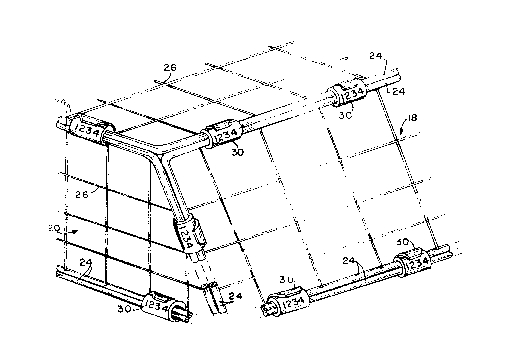Une partie des informations de ce site Web a été fournie par des sources externes. Le gouvernement du Canada n'assume aucune responsabilité concernant la précision, l'actualité ou la fiabilité des informations fournies par les sources externes. Les utilisateurs qui désirent employer cette information devraient consulter directement la source des informations. Le contenu fourni par les sources externes n'est pas assujetti aux exigences sur les langues officielles, la protection des renseignements personnels et l'accessibilité.
L'apparition de différences dans le texte et l'image des Revendications et de l'Abrégé dépend du moment auquel le document est publié. Les textes des Revendications et de l'Abrégé sont affichés :
| (12) Brevet: | (11) CA 2145028 |
|---|---|
| (54) Titre français: | CONSTRUCTION D'UN PIEGE OU D'UNE CAGE A HOMARDS |
| (54) Titre anglais: | LOBSTER TRAP/ANIMAL CAGE CONSTRUCTION |
| Statut: | Périmé et au-delà du délai pour l’annulation |
| (51) Classification internationale des brevets (CIB): |
|
|---|---|
| (72) Inventeurs : |
|
| (73) Titulaires : |
|
| (71) Demandeurs : | |
| (74) Agent: | NORTON ROSE FULBRIGHT CANADA LLP/S.E.N.C.R.L., S.R.L. |
| (74) Co-agent: | |
| (45) Délivré: | 1999-11-16 |
| (22) Date de dépôt: | 1995-03-20 |
| (41) Mise à la disponibilité du public: | 1995-10-20 |
| Requête d'examen: | 1995-06-12 |
| Licence disponible: | S.O. |
| Cédé au domaine public: | S.O. |
| (25) Langue des documents déposés: | Anglais |
| Traité de coopération en matière de brevets (PCT): | Non |
|---|
| (30) Données de priorité de la demande: | ||||||
|---|---|---|---|---|---|---|
|
A wire trap or animal cage having walls which are
attached together by crimped clips at spaced locations
between the adjacent walls o~ the trap or cage. The clips
have markings thereon to indicate ownership of the trap. The
marks may be put on the clips as they are clinched together
around the wires, or the marks may be put on the clips before
the clips are crimped around the wires.
Note : Les revendications sont présentées dans la langue officielle dans laquelle elles ont été soumises.
Note : Les descriptions sont présentées dans la langue officielle dans laquelle elles ont été soumises.

2024-08-01 : Dans le cadre de la transition vers les Brevets de nouvelle génération (BNG), la base de données sur les brevets canadiens (BDBC) contient désormais un Historique d'événement plus détaillé, qui reproduit le Journal des événements de notre nouvelle solution interne.
Veuillez noter que les événements débutant par « Inactive : » se réfèrent à des événements qui ne sont plus utilisés dans notre nouvelle solution interne.
Pour une meilleure compréhension de l'état de la demande ou brevet qui figure sur cette page, la rubrique Mise en garde , et les descriptions de Brevet , Historique d'événement , Taxes périodiques et Historique des paiements devraient être consultées.
| Description | Date |
|---|---|
| Inactive : CIB de MCD | 2006-03-11 |
| Inactive : CIB de MCD | 2006-03-11 |
| Inactive : CIB de MCD | 2006-03-11 |
| Inactive : CIB de MCD | 2006-03-11 |
| Inactive : CIB de MCD | 2006-03-11 |
| Le délai pour l'annulation est expiré | 2005-03-21 |
| Lettre envoyée | 2004-03-22 |
| Accordé par délivrance | 1999-11-16 |
| Inactive : Page couverture publiée | 1999-11-15 |
| Inactive : Taxe finale reçue | 1999-08-12 |
| Préoctroi | 1999-08-12 |
| Inactive : Pages reçues à l'acceptation | 1999-04-19 |
| Lettre envoyée | 1999-02-26 |
| Un avis d'acceptation est envoyé | 1999-02-26 |
| Un avis d'acceptation est envoyé | 1999-02-26 |
| Inactive : Renseign. sur l'état - Complets dès date d'ent. journ. | 1999-02-22 |
| Inactive : Dem. traitée sur TS dès date d'ent. journal | 1999-02-22 |
| Inactive : CIB attribuée | 1999-01-20 |
| Inactive : Approuvée aux fins d'acceptation (AFA) | 1999-01-14 |
| Lettre envoyée | 1997-06-09 |
| Exigences de rétablissement - réputé conforme pour tous les motifs d'abandon | 1997-05-08 |
| Réputée abandonnée - omission de répondre à un avis sur les taxes pour le maintien en état | 1997-03-20 |
| Inactive : Demande ad hoc documentée | 1997-03-20 |
| Demande publiée (accessible au public) | 1995-10-20 |
| Exigences pour une requête d'examen - jugée conforme | 1995-06-12 |
| Toutes les exigences pour l'examen - jugée conforme | 1995-06-12 |
| Date d'abandonnement | Raison | Date de rétablissement |
|---|---|---|
| 1997-03-20 |
Le dernier paiement a été reçu le 1999-03-17
Avis : Si le paiement en totalité n'a pas été reçu au plus tard à la date indiquée, une taxe supplémentaire peut être imposée, soit une des taxes suivantes :
Veuillez vous référer à la page web des taxes sur les brevets de l'OPIC pour voir tous les montants actuels des taxes.
| Type de taxes | Anniversaire | Échéance | Date payée |
|---|---|---|---|
| Rétablissement | 1997-05-08 | ||
| TM (demande, 2e anniv.) - petite | 02 | 1997-03-20 | 1997-05-08 |
| TM (demande, 3e anniv.) - petite | 03 | 1998-03-20 | 1998-03-17 |
| TM (demande, 4e anniv.) - petite | 04 | 1999-03-22 | 1999-03-17 |
| Taxe finale - petite | 1999-08-12 | ||
| TM (brevet, 5e anniv.) - petite | 2000-03-20 | 2000-03-06 | |
| TM (brevet, 6e anniv.) - petite | 2001-03-20 | 2001-03-06 | |
| TM (brevet, 7e anniv.) - petite | 2002-03-20 | 2002-02-26 | |
| TM (brevet, 8e anniv.) - petite | 2003-03-20 | 2003-02-18 |
Les titulaires actuels et antérieures au dossier sont affichés en ordre alphabétique.
| Titulaires actuels au dossier |
|---|
| CHARLES A. MELANSON |
| Titulaires antérieures au dossier |
|---|
| S.O. |